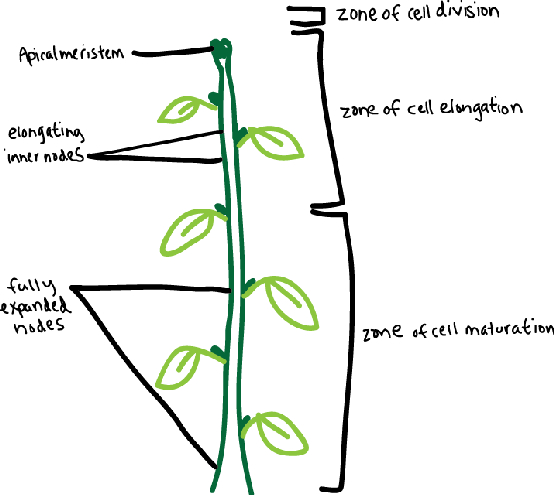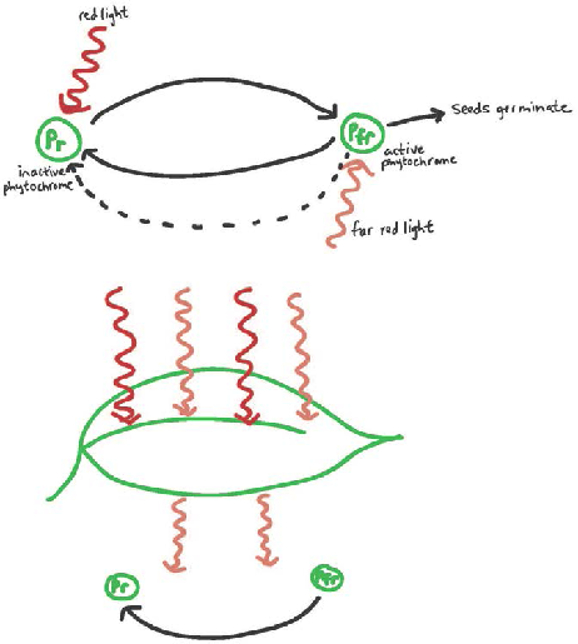Chapter 31 Summary
Core Concepts Summary
31.1 In plants, upward growth by stems occurs at shoot apical meristems, populations of totipotent cells that produce new cells for the lifetime of the plant.
Stems are built from repeating modules consisting of nodes, where one or more leaves are attached, and internodes, which are the regions of stem between the nodes. page 642
The shoot apical meristem, located at the tip of each stem, is the source of new cells from which the stem and the leaves are formed. page 642
Stems contain zones of cell division, elongation, and maturation. Most of the increase in size occurs in the zone of cell elongation. page 643
In seed plants, branching occurs at axillary buds at the base of each leaf. page 644
Leaves differ from stems in that they differentiate fully and thus have no capacity for continued growth. page 645
Leaves develop from leaf primordia produced by the shoot apical meristem. page 645
In most seed plants, the stem’s vascular bundles are organized as a ring. page 646
665
Shoot apical meristems and axillary buds can be transformed into floral meristems, at which point they lose their capacity for continued growth. page 646
31.2 Hormones are chemical signals that influence the growth and differentiation of plant cells.
Traditionally, five plant hormones have been identified: auxin, gibberellic acid, cytokinins, ethylene, and abscisic acid. page 647
Xylem and phloem differentiate from procambial cells. page 649
The polar transport of auxin through PIN proteins guides the formation of leaf primordia and the development of vascular channels (xylem and phloem) that connect leaves and stems. page 649
Gibberellic acid causes internodal elongation of shoots. page 650
Apical dominance is the suppression of the outgrowth of axillary buds caused by hormones produced by roots (strigolactone) and shoots (auxin). page 650
31.3 Lateral meristems allow plants to grow in diameter, increasing their mechanical stability and the transport capacity of their vascular system.
The formation of two lateral meristems—
The vascular cambium produces secondary xylem toward the center and phloem toward the outside. page 651
The cork cambium produces a protective outer layer. page 652
Gymnosperm tracheids function in both mechanical support and water transport. Angiosperm xylem produces fibers that influence the strength of wood and vessel elements that function in water transport. page 653
31.4 The root apical meristem produces new cells that allow roots to grow downward into the soil, enabling plants to obtain water and nutrients.
The root apical meristem is the source of new cells that allow roots to elongate. page 654
The root apical meristem has a cap that protects it from damage as the root grows through the soil. page 654
The root’s vascular tissues are located in the center of the root, surrounded by the pericycle, the endodermis, the cortex, and the epidermis. page 654
Lateral roots develop from new root apical meristems that form in the pericycle. page 655
Roots alter their development in response to conditions in the soil. page 655
Some roots are involved in adhesion, storage, and gas diffusion. page 656
31.5 Plants respond to light, gravity, and wind through changes in internode elongation and the development of leaves, roots, and branches.
Plant stems grow toward the light and away from gravity as a result of redistribution of auxin. page 656
Roots grow away from light and toward gravity as a result of redistribution of auxin. page 656
Starch-
Phytochrome is a photoreceptor that allows plants to determine the amount of red versus far-
Seedlings germinating in the dark produce elongated internodes and suppress leaf expansion to increase their ability to reach the soil surface before their stored resources are depleted. page 660
Some plants respond to the presence of neighboring plants by elongating more rapidly and suppressing branching, which allow them to maximize height growth. page 660
Mechanical stress, such as the bending of stems in the wind, results in stems that are short and wide. page 661
31.6 Plants have sensory systems that control the timing of developmental events.
Many plants are photoperiodic, meaning that their flowering is controlled by the day length. page 662
Plants measure day length through an interaction between photoreceptors and their internal circadian clock. page 663
Vernalization is a prolonged period of exposure to cold temperatures necessary in some temperate-
Decreases in photoperiod trigger plants to prepare their meristems for winter by producing bud scales and reducing internode elongation. page 664
Self-Assessment
Diagram the zones of cell division, elongation, and maturation, and explain why this organization allows stems to grow without a predetermined limit to their length.
Self-Assessment 1 Answer
Stems can grow without a predetermined limit to their length because the apical meristem is continually making new cells, while the older cells are still elongating, pushing the apical meristem up.

666
Name one role of the plant hormone auxin and describe how auxin is transported within a plant.
Self-Assessment 2 Answer
Auxin is responsible for stimulating the formation of root meristems, as well as guiding the development of vascular connections between leaves and stem, and between leaves and roots. It also causes shoots to elongate, causes branching to be suppressed, and helps orient stems toward the light.
Auxin is transported by polar transport, which is the coordinated movement across many cells in a particular direction. Auxin can only exit cells through PIN proteins, so the placement of PIN proteins on the basal side of each cell will cause auxin to flow from the tip to the base of a plant. Auxin can also be carried in the phloem.
Explain why a plant that has a vascular cambium also has a cork cambium.
Self-Assessment 3 Answer
Cork, produced by cork cambium, protects the stem of the plant against herbivores, mechanical damage, desiccation, and, in some cases, fire. The plant needs this protection because as the activities of the vascular cambium increase the plant’s diameter, the primary epidermis eventually ruptures.
Explain why the vascular cambium forms a continuous sheath that runs from near the tips of the branches to near the tips of the roots, whereas the cork cambium is discontinuous in both space and time.
Self-Assessment 4 Answer
The vascular cambium forms a continuous sheath from root to tip; as a result, it produces xylem and phloem along the length of the plant. Cork cambium is discontinuous in both space and time because it is relatively short-
lived. The cork cambium eventually becomes cut off from its source of carbohydrates— the phloem. A new cork cambium is formed when the distance between the original cork cambium and the functional phloem grows too large. In many cases, cork cambium forms in patches rather than as a continuous layer. List three structural differences between roots and shoots that allow roots to grow through the soil. Explain how you would tell whether an isolated piece of a plant came from the shoot or from the root.
Self-Assessment 5 Answer
Roots are typically much thinner than stems, allowing them to grow around particles in densely packed soil. The root apical meristem is also protected by a root cap as the root grows through the soil. Finally, the root apical meristem does not produce any lateral organs such as leaves.
You can identify a root in several ways. First, does it have a root cap surrounding the apical meristem? Second, are there thin projections, root hairs, growing from the zone of maturation? Third, how big is the tissue in relation to the rest of the plant (as roots are typically thinner)? Fourth, is the tissue able to photosynthesize and is thus green (root tissue is not usually green)?
Discuss the similarities and differences in the ways stems and roots respond to gravity and light.
Self-Assessment 6 Answer
Stems and roots use the same signals to respond to gravity and light, but their responses are opposite. In the stem, light detected by photoreceptors signals the stem to preferentially transport auxin to the shaded side, causing the cells on that side to expand and the stem to bend toward the light. In roots, auxin is again transported to the shaded side of the root, but in this case the rate of cell elongation decreases on that side and the root bends away from the light. When stems or roots respond to gravity, auxin accumulates on the lower surface (in response to the movement of heavy starch-
filled organelles), but the stem bends up whereas the roots turn down. Diagram how the amount of red versus far-
red light allows plants to determine if they are in the open or in the forest understory. Self-Assessment 7 Answer

Give an example of how a plant’s ability to sense its environment improves the plant’s chances for survival and reproduction.
Self-Assessment 8 Answer
There are many examples of how a plant’s ability to sense its environment improves the plant’s chances for survival and reproduction. (1) Plants suited to growing in direct sunlight grow taller and branch less when light levels are low. This strategy allows the plant to put energy into reaching the light. (2) Roots elongate more and branch less when water is scarce. The root system is thus able to go deeper into the soil, increasing the plant’s chance of encountering water reserves. (3) Exposure to wind results in shorter and stronger stems that help the plant withstand the mechanical stress of high winds. (4) Plants use day length as a cue to prepare for winter. For example, the shortened length of daylight signals the approach of winter; the plant creates storage organs in the roots that will provide nutrients for the growth of new leaves and stems the following spring.
Explain why a short-
day plant that germinates in the spring will not flower until late summer and why a long- day plant that germinates at the end of summer will not flower until late the following spring. Self-Assessment 9 Answer
The expression of a gene that allows plants to flower varies with a circadian rhythm, controlled by an internal clock. The protein expressed by the gene is stabilized by light, which is sensed by the plants’ photoreceptors. The protein accumulates only when there is overlap between high rates of gene expression and stabilization of the protein by light.
Describe how vernalization can have an effect in cells that were not formed at the time of the cold treatment.
Self-Assessment 10 Answer
Vernalization is the process in plants in which flowering can be induced only if the plant has experienced a prolonged period of cold temperatures. The mechanism acts through chromatin remodeling. Chromatin remodeling is stable through mitotic divisions, explaining why newly formed parts of a plant “remember” developmental events.